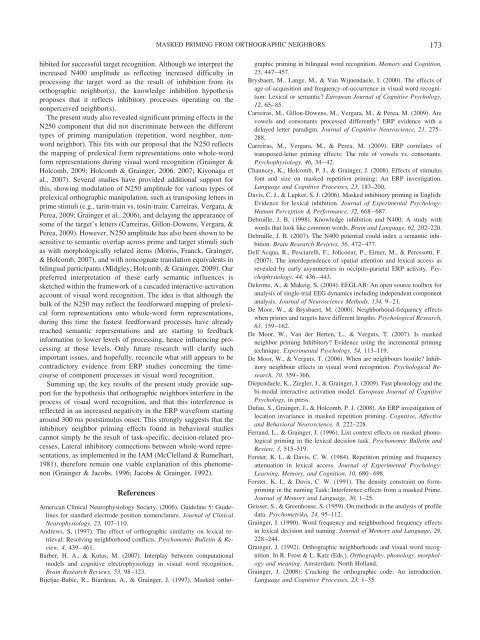Masked Priming From Orthographic Neighbors: An ERP Investigation
Masked Priming From Orthographic Neighbors: An ERP Investigation
Masked Priming From Orthographic Neighbors: An ERP Investigation
Create successful ePaper yourself
Turn your PDF publications into a flip-book with our unique Google optimized e-Paper software.
MASKED PRIMING FROM ORTHOGRAPHIC NEIGHBORS173hibited for successful target recognition. Although we interpret theincreased N400 amplitude as reflecting increased difficulty inprocessing the target word as the result of inhibition from itsorthographic neighbor(s), the knowledge inhibition hypothesisproposes that it reflects inhibitory processes operating on thenonperceived neighbor(s).The present study also revealed significant priming effects in theN250 component that did not discriminate between the differenttypes of priming manipulation (repetition, word neighbor, nonwordneighbor). This fits with our proposal that the N250 reflectsthe mapping of prelexical form representations onto whole-wordform representations during visual word recognition (Grainger &Holcomb, 2009; Holcomb & Grainger, 2006, 2007; Kiyonaga etal., 2007). Several studies have provided additional support forthis, showing modulation of N250 amplitude for various types ofprelexical orthographic manipulation, such as transposing letters inprime stimuli (e.g., tarin-train vs. tosin-train: Carreiras, Vergara, &Perea, 2009; Grainger et al., 2006), and delaying the appearance ofsome of the target’s letters (Carreiras, Gillon-Dowens, Vergara, &Perea, 2009). However, N250 amplitude has also been shown to besensitive to semantic overlap across prime and target stimuli suchas with morphologically related items (Morris, Franck, Grainger,& Holcomb, 2007), and with noncognate translation equivalents inbilingual participants (Midgley, Holcomb, & Grainger, 2009). Ourpreferred interpretation of these early semantic influences issketched within the framework of a cascaded interactive-activationaccount of visual word recognition. The idea is that although thebulk of the N250 may reflect the feedforward mapping of prelexicalform representations onto whole-word form representations,during this time the fastest feedforward processes have alreadyreached semantic representations and are starting to feedbackinformation to lower levels of processing, hence influencing processingat those levels. Only future research will clarify suchimportant issues, and hopefully, reconcile what still appears to becontradictory evidence from <strong>ERP</strong> studies concerning the timecourseof component processes in visual word recognition.Summing up, the key results of the present study provide supportfor the hypothesis that orthographic neighbors interfere in theprocess of visual word recognition, and that this interference isreflected in an increased negativity in the <strong>ERP</strong> waveform startingaround 300 ms poststimulus onset. This strongly suggests that theinhibitory neighbor priming effects found in behavioral studiescannot simply be the result of task-specific, decision-related processes.Lateral inhibitory connections between whole-word representations,as implemented in the IAM (McClelland & Rumelhart,1981), therefore remain one viable explanation of this phenomenon(Grainger & Jacobs, 1996; Jacobs & Grainger, 1992).ReferencesAmerican Clinical Neurophysiology Society. (2006). Guideline 5: Guidelinesfor standard electrode position nomenclature. Journal of ClinicalNeurophysiology, 23, 107–110.<strong>An</strong>drews, S. (1997). The effect of orthographic similarity on lexical retrieval:Resolving neighborhood conflicts. Psychonomic Bulletin & Review,4, 439–461.Barber, H. A., & Kutas, M. (2007). Interplay between computationalmodels and cognitive electrophysiology in visual word recognition.Brain Research Reviews, 53, 98–123.Bijeljac-Babic, R., Biardeau, A., & Grainger, J. (1997). <strong>Masked</strong> orthographicpriming in bilingual word recognition. Memory and Cognition,25, 447–457.Brysbaert, M., Lange, M., & Van Wijnendaele, I. (2000). The effects ofage-of-acquisition and frequency-of-occurrence in visual word recognition:Lexical or semantic? European Journal of Cognitive Psychology,12, 65–85.Carreiras, M., Gillon-Dowens, M., Vergara, M., & Perea, M. (2009). Arevowels and consonants processed differently? <strong>ERP</strong> evidence with adelayed letter paradigm. Journal of Cognitive Neuroscience, 21, 275–288.Carreiras, M., Vergara, M., & Perea, M. (2009). <strong>ERP</strong> correlates oftransposed-letter priming effects: The role of vowels vs. consonants.Psychophysiology, 46, 34–42.Chauncey, K., Holcomb, P. J., & Grainger, J. (2008). Effects of stimulusfont and size on masked repetition priming: <strong>An</strong> <strong>ERP</strong> investigation.Language and Cognitive Processes, 23, 183–200.Davis, C. J., & Lupker, S. J. (2006). <strong>Masked</strong> inhibitory priming in English:Evidence for lexical inhibition. Journal of Experimental Psychology:Human Perception & Performance, 32, 668–687.Debruille, J. B. (1998). Knowledge inhibition and N400: A study withwords that look like common words. Brain and Language, 62, 202–220.Debruille, J. B. (2007). The N400 potential could index a semantic inhibition.Brain Research Reviews, 56, 472–477.Dell’Acqua, R., Pesciarelli, F., Jolicoeur, P., Eimer, M., & Peressotti, F.(2007). The interdependence of spatial attention and lexical access asrevealed by early asymmetries in occipito-parietal <strong>ERP</strong> activity. Psychophysiology,44, 436–443.Delorme, A., & Makeig, S. (2004). EEGLAB: <strong>An</strong> open source toolbox foranalysis of single-trial EEG dynamics including independent componentanalysis. Journal of Neuroscience Methods, 134, 9–21.De Moor, W., & Brysbaert, M. (2000). Neighborhood-frequency effectswhen primes and targets have different lengths. Psychological Research,63, 159–162.De Moor, W., Van der Herten, L., & Verguts, T. (2007). Is maskedneighbor priming Inhibitory? Evidence using the incremental primingtechnique. Experimental Psychology, 54, 113–119.De Moor, W., & Verguts, T. (2006). When are neighbours hostile? Inhibitoryneighbour effects in visual word recognition. Psychological Research,70, 359–366.Diependaele, K., Ziegler, J., & Grainger, J. (2009). Fast phonology and thebi-modal interactive activation model. European Journal of CognitivePsychology, in press.Dufau, S., Grainger, J., & Holcomb, P. J. (2008). <strong>An</strong> <strong>ERP</strong> investigation oflocation invariance in masked repetition priming. Cognitive, Affectiveand Behavioral Neuroscience, 8, 222–228.Ferrand, L., & Grainger, J. (1996). List context effects on masked phonologicalpriming in the lexical decision task. Psychonomic Bulletin andReview, 3, 515–519.Forster, K. I., & Davis, C. W. (1984). Repetition priming and frequencyattenuation in lexical access. Journal of Experimental Psychology:Learning, Memory, and Cognition, 10, 680–698.Forster, K. I., & Davis, C. W. (1991). The density constraint on formprimingin the naming Task: Interference effects from a masked Prime.Journal of Memory and Language, 30, 1–25.Geisser, S., & Greenhouse, S. (1959). On methods in the analysis of profiledata. Psychometrika, 24, 95–112.Grainger, J. (1990). Word frequency and neighborhood frequency effectsin lexical decision and naming. Journal of Memory and Language, 29,228–244.Grainger, J. (1992). <strong>Orthographic</strong> neighborhoods and visual word recognition.In R. Frost & L. Katz (Eds.), Orthography, phonology, morphologyand meaning. Amsterdam: North Holland.Grainger, J. (2008). Cracking the orthographic code: <strong>An</strong> introduction.Language and Cognitive Processes, 23, 1–35.
















